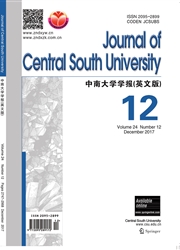

 中文摘要:
中文摘要:
联合适应波形设计和基线范围的问题设计让 bistatic 雷达最大化分辨率被考虑的实际雷达。与常规歧义函数( AF )区分开来基于仅仅与播送波形和 bistatic 几何学被联系并且能被认为是一个 bistatic 雷达系统的潜在的分辨率的分辨率,实际分辨率包含波形的效果,象测量模型一样的 signal-to-noise 比率( SNR )。因此,它是更实际的并且将在目标察觉有进一步重要的申请并且追踪。为在动态目标情形下面最大化 bistatic 雷达系统的实际决定的联合适应波形设计和基线范围设计的限制优化过程被设计。模拟结果证明范围和速度决定根据适应波形和 bistatic 雷达配置被提高。
 英文摘要:
英文摘要:
The problems of joint adaptive waveform design and baseline range design for bistatic radar to maximize the practical radar resolution were considered. Distinguishing from the conventional ambiguity function (AF)-based resolution which is only related with the transmitted waveform and bistatic geometry and could be regarded as the potential resolution of a bistatic radar system, the practical resolution involves the effect of waveform, signal-to-noise ratio (SNR) as well as the measurement model. Thus, it is more practical and will have further significant application in target detection and tracking. The constraint optimization procedure of joint adaptive waveform design and baseline range design for maximizing the practical resolution of bistatic radar system under dynamic target scenario was devised. Simulation results show that the range and velocity resolution are enhanced according to the adaptive waveform and bistatic radar configuration.
 同期刊论文项目
同期刊论文项目
 同项目期刊论文
同项目期刊论文
 Scattering characteristics for cylindrical conductor with different surface micro-structure in terah
Scattering characteristics for cylindrical conductor with different surface micro-structure in terah Electromagnetic scattering characteristic of aluminous targets in the terahertz and far infrared reg
Electromagnetic scattering characteristic of aluminous targets in the terahertz and far infrared reg Vibration Target Detection and Vibration Parameters Estimation based on the DPCA Technique in Dual-c
Vibration Target Detection and Vibration Parameters Estimation based on the DPCA Technique in Dual-c Discrete chirp-Fourier transform-based acquisition algorithm for weak global positioning system L5 s
Discrete chirp-Fourier transform-based acquisition algorithm for weak global positioning system L5 s Pulse-repetition-interval transform based vibrating target detection and estimation in synthetic ape
Pulse-repetition-interval transform based vibrating target detection and estimation in synthetic ape ISAR imaging of targets with complex motion based on discrete chirp Fourier transform for cubic chir
ISAR imaging of targets with complex motion based on discrete chirp Fourier transform for cubic chir 期刊信息
期刊信息
